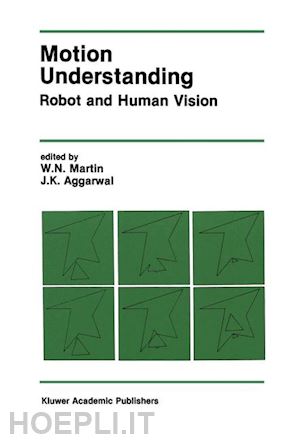
Questo prodotto usufruisce delle SPEDIZIONI GRATIS
selezionando l'opzione Corriere Veloce in fase di ordine.
Pagabile anche con Carta della cultura giovani e del merito, 18App Bonus Cultura e Carta del Docente
1 Bounding Constraint Propagation for Optical Flow Estimation.- 1.1 Introduction.- 1.2 The Gradient Constraint Equation.- 1.3 Gradient-Based Algorithms.- 1.4 Coping with Smoothness Violations.- 1.5 Results.- 1.6 Discussion.- 2 Image Flow: Fundamentals and Algorithms.- 2.1 Introduction.- 2.2 Simple Image Flows.- 2.3 Discontinuous Image Flow.- 2.4 Analysis of Discontinuous Image Flows.- 2.5 Algorithms for Discontinuous Image Flows.- 2.6 Smoothing Discontinuous Image Flows.- 2.7 Summary and Conclusions.- 3 A Computational Approach to the Fusion of Stereopsis and Kineopsis.- 3.1 Introduction.- 3.2 Integrating Optical Flow to Stereopsis for Motion.- 3.3 Perception of Rigid Objects in Motion.- 3.4 Examples.- 3.5 Summary.- 4 The Empirical Study of Structure from Motion.- 4.1 Introduction.- 4.2 Viewer-Centered vs. Object-Centered Depth.- 4.3 The Correspondence Problem.- 4.4 Rigidity.- 4.5 Perception of Self Motion.- 4.6 A Theory of Observers.- 4.7 An Empirical Test of Constraints.- 4.8 Summary and Conclusions.- 5 Motion Estimation Using More Than Two Images.- 5.1 Introduction.- 5.2 General Description of the Method.- 5.3 Results.- 5.4 Comparison with Other Methods.- 5.5 Conclusions.- 6 An Experimental Investigation of Estimation Approaches for Optical Flow Fields.- 6.1 Introduction.- 6.2 Feature Based Estimation.- 6.3 Analytical Approach for the Estimation of Optical Flow Vector Fields.- 6.4 Discussion.- 7 The Incremental Rigidity Scheme and Long-Range Motion Correspondence.- 7.1 The Rigidity-Based Recovery of Structure from Motion.- 7.2 The Incremental Rigidity Scheme.- 7.3 Experimental Results.- 7.4 Additional Properties of the Incremental Rigidity Scheme.- 7.5 Possible Implications to the Long-Range Motion Correspondence Process.- 7.6 Summary.- 8 Some Problems with Correspondence.- 8.1 Introduction.- 8.2 Determining Correspondence.- 8.3 Correspondence in Computer Vision.- 8.4 An Experiment on Correspondence.- 8.5 Conclusions.- 9 Recovering Connectivity from Moving Point-Light Displays.- 9.1 Introduction.- 9.2 Motion Information is a Minimal Stimulus Condition for the Perception of Form.- 9.3 Processing Models for Recovering Form from Motion.- 9.4 Do Fixed-Axis Models Predict Human Performance?.- 9.5 Human Implementation of Additional Processing Constraints.- 9.6 Incompatibilities Between Human Performance and Models Seeking Local Rigidity.- 9.7 Conclusion.- 10 Algorithms for Motion Estimation Based on Three-Dimensional Correspondences.- 10.1 Introduction.- 10.2 Direct Linear Method.- 10.3 Method Based on Translation Invariants.- 10.4 Axis-Angle Method.- 10.5 The Screw Decomposition Method.- 10.6 Improved Motion Estimation Algorithms.- 10.7 Comparing the Linear and Nonlinear Methods.- 10.8 Simulation Results for Three-Point Methods.- 10.9 Some Recent Related Results.- 11 Towards a Theory of Motion Understanding in Man and Machine.- 11.1 Introduction.- 11.2 The Time Complexity of Visual Perception.- 11.3 Measurement and Hierarchical Representations in Early Vision.- 11.4 Biological Research.- 11.5 Machine Research.- Author Index.











Il sito utilizza cookie ed altri strumenti di tracciamento che raccolgono informazioni dal dispositivo dell’utente. Oltre ai cookie tecnici ed analitici aggregati, strettamente necessari per il funzionamento di questo sito web, previo consenso dell’utente possono essere installati cookie di profilazione e marketing e cookie dei social media. Cliccando su “Accetto tutti i cookie” saranno attivate tutte le categorie di cookie. Per accettare solo deterninate categorie di cookie, cliccare invece su “Impostazioni cookie”. Chiudendo il banner o continuando a navigare saranno installati solo cookie tecnici. Per maggiori dettagli, consultare la Cookie Policy.